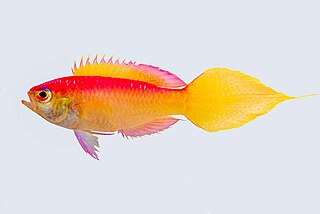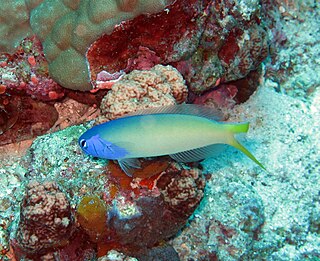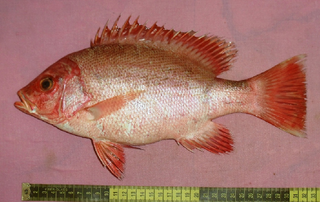
Sebastes norvegicus, the rose fish, rock fish, ocean perch, Atlantic redfish, Norway haddock, golden redfish, pinkbelly rosefish, Norway seaperch, Scottish seaperch or bergylt, is a species of marine ray-finned fish belonging to the subfamily Sebastinae, the rockfishes, part of the family Scorpaenidae. It is found in the North Atlantic Ocean. It is a large, slow-growing, late-maturing fish and the subject of a fishery.

Callanthiidae, the splendid perches and groppos is a small family of marine ray-finned fishes in the order Spariformes. These fishes are mainly found in the Indo-Pacific but two species are found in the eastern Atlantic and Mediterranean.

The splendid sea perch, also called the rosy perch, Allport's groppo, Allport's perch, Southern goldie or Southern splendid perch is a species of marine ray-finned fish belonging to the family Callanthiidae. This fish is found off southern Australia and New Zealand.

Helicolenus is a genus of marine ray-finned fishes belonging to the family Scorpaenidae where they are classified within the subfamily Sebastinae, the rockfishes. The species in this genus are found in the Indian, Atlantic and Pacific oceans.
Idiastion is a small genus of marine ray-finned fish belonging to the family Scorpaenidae, the scorpionfishes. They are found in the Atlantic and Pacific oceans.

Mycteroperca is a genus of marine ray-finned fish, groupers from the subfamily Epinephelinae, part of the family Serranidae, which also includes the anthias and sea basses. They are predatory fish, largely associated with reefs and are found in tropical and subtropical seas in the Atlantic Ocean and the eastern Pacific Ocean. They are important target species for fisheries.

Hoplolatilus starcki, Stark's tilefish, purple-headed sand tilefish or bluehead tilefish, is a species of marine ray-finned fish, a tilefish belonging to the family Malacanthidae. This species is native to the central Indo-Pacific.

Bellator is a genus of marine ray-finned fishes belonging to the family Triglidae, one of two genera belonging to the subfamily Prionotinae, the sea robins. These fishes are found in the Western Atlantic Ocean and eastern Pacific Ocean, in the waters off both North and South America.

Ectreposebastes is a genus of marine ray-finned fish, belonging to the subfamily Setarchinae, the deep-sea bristly scorpionfishes, part of the family Scorpaenidae. The genus is found in the Atlantic, Indian and Pacific Oceans.

Grammatonotus is a genus of marine ray-finned fishes belonging to the family Callanthiidae, which includes the splendid perches and groppos. These fishes are found in the Indian and Pacific Ocean. All of the species in the genus are known in English as groppos.

Emmelichthys is a genus of marine ray-finned fishes belonging to the family Emmelichthyidae, the rovers and bonnetmouths. The species in this genus are found in the Atlantic, Indian and Pacific Oceans.

Branchiostegus is a genus of marine ray-finned fishes, tilefishes, belonging to the family Malacanthidae. They are found in the eastern Atlantic Ocean through the Indian Ocean to the western Pacific Ocean. Here they create burrows in soft substrates in the comparatively deep waters of the continental shelf and slope.

Sciaena is a genus of marine ray-finned fishes belonging to the family Sciaenidae, the drums and croakers. These fishes are found in the Eastern Pacific Ocean and the Eastern Atlantic Ocean.

Bairdiella is a genus of marine ray-finned fishes belonging to the family Sciaenidae, the drums and croakers. These fishes are found in the western Atlantic and eastern Pacific Ocean.

Lutjanus erythropterus, the crimson snapper, crimson seaperch, high-brow sea-perch, Longman's sea perch, red bream, saddle-tailed perch, small-mouth nannygai or smallmouth sea perch is a species of marine ray-finned fish, a snapper belonging to the family Lutjanidae. It is found in the Pacific and Indian Oceans.

Lutjanus johnii, the Golden snapper, John’s snapper,big-scaled bream, fingermark bream, fingerbanger, fingermark seaperch, John's sea-perch, or spotted-scale sea perch, is a species of marine ray-finned fish, a snapper belonging to the family Lutjanidae. It is native to the western Pacific and Indian Oceans.

Anthias anthias, the swallowtail sea perch or marine goldfish, is a species of marine ray-finned fish from the family Anthiadidae. It is native to the eastern Atlantic Ocean and the Mediterranean Sea where it is associated with reefs. It is found in the aquarium trade.
Callanthias legars, the goldie or African splendid perch, is a species of marine ray-finned fish belonging to the family Callanthiidae. This species is found in the southeastern Atlantic Ocean off southern Africa.

Callanthias australis, the magnificent sea perch, splendid perch, glorious groppo or Northern splendid perch, is a species of marine ray-finned fish belonging to the family Callanthiidae. This species is found in the southeastern Indian Ocean and the southwestern Pacific Ocean.

The parrot seaperch, also known as the bird of paradise fish or Eastern Atlantic groppo, is a species of marine ray-finned fish belonging to the family Callanthiidae, the splendid perches and groppos. This fish is found in the northeastern Atlantic and Mediterranean.


















